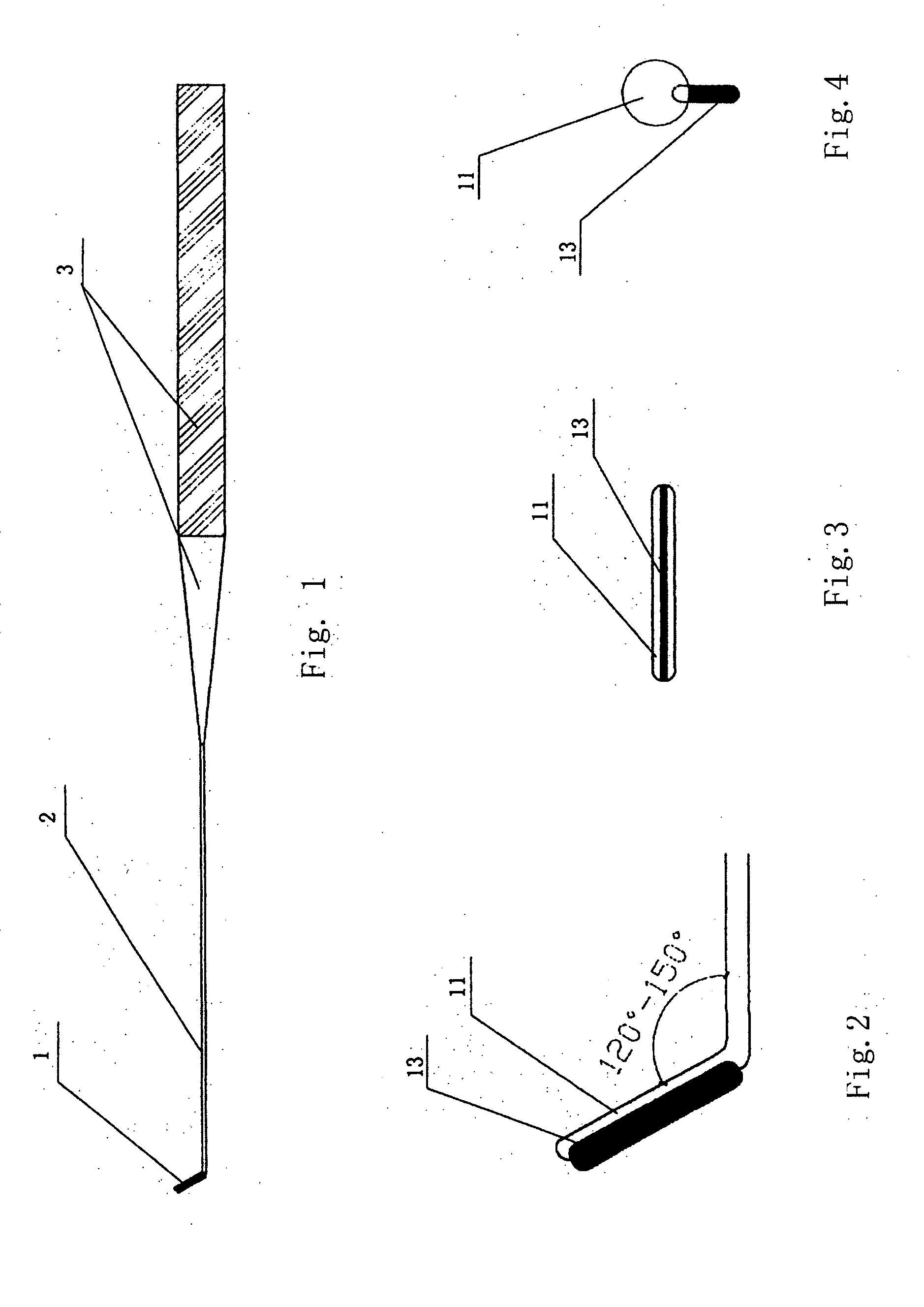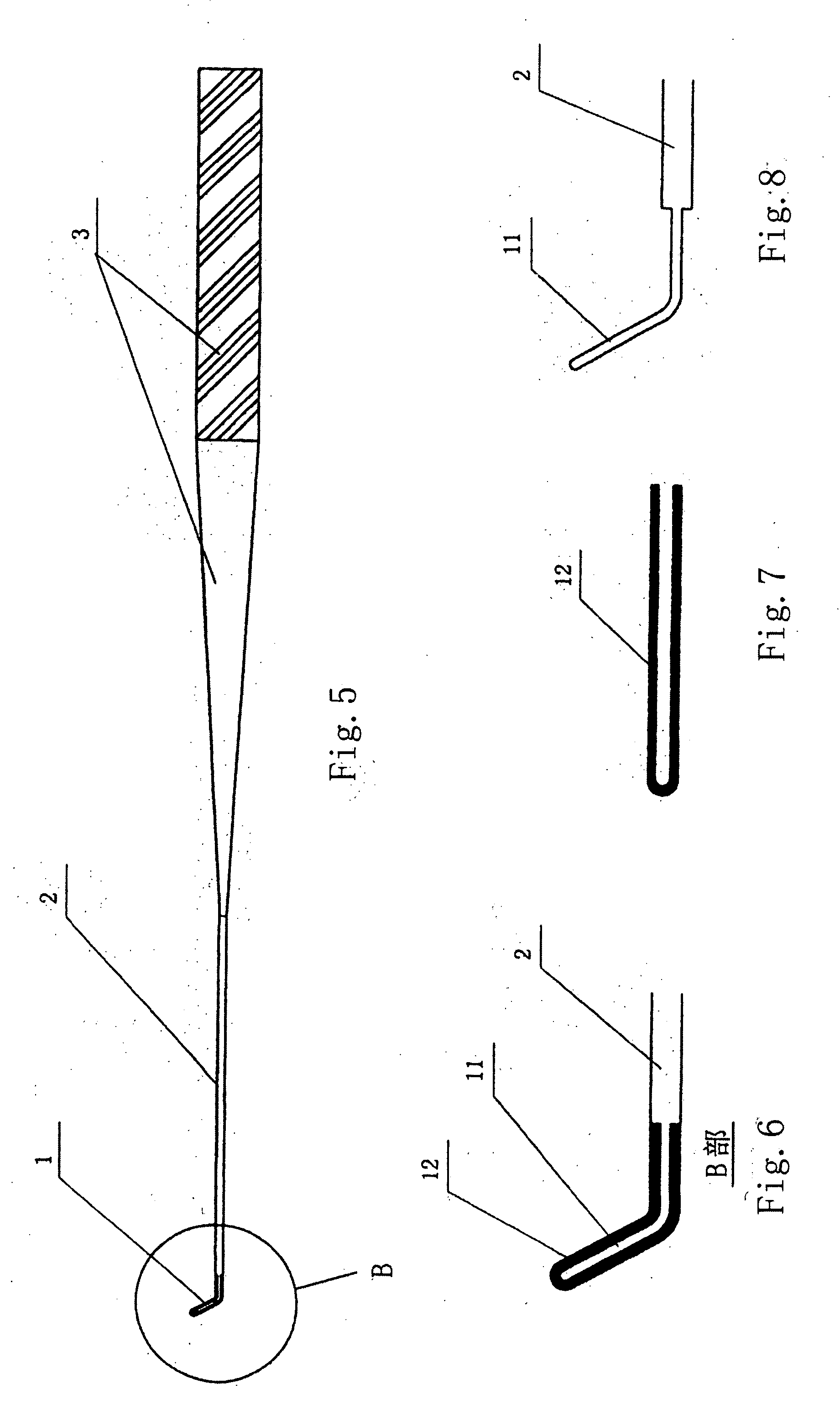Retinal flattener
a retinal flattener and retinal technology, applied in the field of retina flattener, can solve the problems of inability to use such a special device inability to achieve retinal flattening, etc., to save the duration of surgery, improve the effect of the whole operation, and reduce the operation time.
- Summary
- Abstract
- Description
- Claims
- Application Information
AI Technical Summary
Benefits of technology
Problems solved by technology
Method used
Image
Examples
example 1
[0029] As shown in FIG. 1, the retinal flattener contains a working tip 1, a rod 2 and a handle 3, wherein the rod 2 is a metal rod made of stainless steel materials, whose diameter is 0.4 mm and length is 40 mm, and the angle between the working tip 1 and the rod 2 is 120°. The angle can be adjusted finely with hemostatic forceps in operation. The base 11 of the working tip, which is 2 mm long, is the extended part of the rod 2 with the same core (as shown in FIG. 2). A thin piece of silicone film 13, shaped like a brush, is inlaid underside the base 11 as a soft pressing working element. The soft silicone film 13 is 0.1 mm thick and the portion extended from the base dimensions 0.3 mm (as shown in FIGS. 3 and 4). The total length of the retinal flattener is about 110 mm.
[0030] When applying the retinal flattener in operation, at first an operator adjusts the angle of the working tip with hemostatic forceps according to the different areas rubbed down, and then, in order to flat t...
example 2
[0031] As shown in FIG. 5, the retinal flattener contains a working tip 1, a rod 2 and a handle 3, wherein the rod 2 is a metal rod made of stainless steel materials, whose diameter is 0.8 mm and length is 30 mm, and the angle between the working tip 1 and the rod 2 is 120°. The angle can be adjusted finely with hemostatic forceps in operation. The soft pressing element of the working tip is a silicone tube 12 covered over the base, whose wall is 0.2 mm thick (as shown in FIG. 7). The base of the working tip, whose diameter is about 0.4 mm, can be the core 11 of the contracted rod extended from the front end of the rod (as shown in FIG. 8). The total external diameter of the working tip equals to the one of the rod while the silicone tube covers the base (as shown in FIG. 6). The whole retinal flattener is about 130 mm long.
example 3
[0032] As shown in FIG. 9, the retinal flattener contains a working tip 1, a rod 2 and a handle 3, and its structure is the same as the one in Example 2 on the whole. The differences is that as the soft pressing element of the working tip, the silicone tube 12 only covers the front part of the working tip (as shown in FIG. 10). The silicone tube 12 and the base 11 of the working tip are shown in FIGS. 11 and 12.
PUM
 Login to View More
Login to View More Abstract
Description
Claims
Application Information
 Login to View More
Login to View More - R&D
- Intellectual Property
- Life Sciences
- Materials
- Tech Scout
- Unparalleled Data Quality
- Higher Quality Content
- 60% Fewer Hallucinations
Browse by: Latest US Patents, China's latest patents, Technical Efficacy Thesaurus, Application Domain, Technology Topic, Popular Technical Reports.
© 2025 PatSnap. All rights reserved.Legal|Privacy policy|Modern Slavery Act Transparency Statement|Sitemap|About US| Contact US: help@patsnap.com



